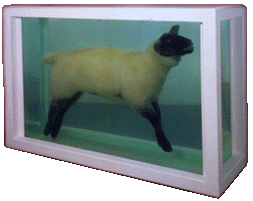 Art
ArtThey also obliged me to reconsider Hirst, who does, after all, force one to reconsider what art is and teaches ways of seeing things differently. His dead sheep, for instance, is horrible yet beautiful. Though it was not at the Gagosian exhibit I saw, I've spent a lot of time staring at photographs of it and trying to explain to myself why it does not belong in an art gallery. Yet the Arte Povera show has convinced me that, ultimately, it does belong, for what Hirst has done is frozen the sheep mid-canter, creating a powerful contrast between the dreadful stillness of the installation and the brisk movement the sheep's body conjures up in my mind. It is not so different from Pistoletto's cube, for much of what I 'see' when I look at the piece is not the object itself but the picture it inspires in the imagination.
Does this make me a convert? Not exactly. The best of installation art, like most things post-modern, reminds me of Clifford Geertz's description of something being "good for thinking." It can be smart, elegant even, but ultimately it is art for the mind. As much as I enjoy that kind of stimulation, viewing Arte Povera makes me realize the extent to which I remain a die-hard Romantic. I can learn to respect installation art. But I prefer art that unites the emotional with the intellectual, art that addresses my heart or even my soul. I was reminded of this the other night when I returned home half-drunk and a little melancholy. I turned on the stereo and listened to Kathleen Battle sing Brahms's "Ihr habt nun Traurigkeit." She made me cry. Can postmodern art do that?

Pierre Bonnard at the Phillips Collection
November, 2002
Why modern art survives in a postmodern age
October, 2002
The Art of the Press Conference
September, 2002
Totalitarianism, kitsch, and Mamma Mia
August, 2002
What is modernism?
July, 2002
What's the difference between laughing with art and laughing at it?
June, 2002
At college drawing classes, looking for the real art among the posing.
May, 2002
What draws protesters to shout about banal holocaust art?
April, 2002



film politics music jay's head poetry art josh ring fysche saddies about archive